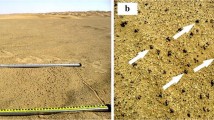Abstract
In sand-control engineering, it is difficult to predict the optimal shrub cover, and to determine the relationship between this shrub cover and shrub height. Based on analysis of the physical mechanisms responsible for wind erosion (specifically, the increase in the threshold friction velocity required to entrain particles), a model was developed for the optimal shrub cover to control wind erosion and the optimal configuration that combines the best shrub cover and height. The value of a shrub plantation for counteracting erosion increases with increasing shrub cover and height, but is more sensitive to shrub cover. The friction wind velocity increases with increasing shrub cover and height. The optimal shrub cover was 60–65%, which confirms the results of previous Chinese field research.



Similar content being viewed by others
References
Buckley R (1987) The effect of sparse vegetation on the transport of dune sand by wind. Nature 325:426–428
Cheng GT (2004) Controlling technology of blown-sand. Chemical Industry Publishers, Beijing
Dong ZB, Fryrear DW, Gao SY (2000) Modeling the roughness effect of blown-sand-controlling standing vegetation in wind tunnel. J Desert Res 9(3):260–263
Dong ZB, Liu XP, Wang XM (2002) Wind initiation thresholds of the moistened sands. Geophys Res Lett 29(12):25–28. doi:10.1029/2001GL013128
Englehorn CL, Zingg AW, Woodruff NP (1952) The effect of plant residue cover and clod structure on soil losses by wind. Soil Sci Soc Am Proc 16:29–33
Fryrear DW (1985) Soil cover and wind erosion. Trans ASAE 28:781–784
Hagen LJ (1991) A wind erosion prediction system to meet the users’ need. J Soil Water Conserv 46:106–111
Lyles L, Allison BE (1981) Equivalent wind-erosion protection from selected crop residues. Trans ASAE 24:405–408
Nickling WG, Ecclestone M (1981) The effects of soluble salts on the threshold shear velocity of fine sand. Sedimentology 28:505–510
Owen PR (1964) Saltation of uniform grains in air. J Fluid Mech 20:225–242
Raupach MR, Gillette AD, Leys JF (1993) The effect of roughness elements on wind erosion threshold. J Geophys Res 98:3023–3029
Shao Y, Raupach MR, Leys JF (1996) A model for predicting aeolian sand drift entrainment on scales from paddock to region. Aust J Soil Res 34(2):309–342
Shen YB (2005) Calculation and numerical simulation of sand and dust emissions by wind erosion in Northwest China. PhD Thesis, Graduate University of the Chinese Academy of Sciences, Beijing
van den Ven TAM, Fryrear DW, Spaan WS (1989) Vegetation characteristics and soil loss by wind. J Soil Water Conserv 44(4):347–349
Wang ZQ, Liu BY, Wang XL (2005) Effects of natural shrub of Caragana opulens kom. on soil moisture in a semiarid on the loess plateau. Geogr Res 24(1):113–120
Wasson RJ, Nanninga PM (1986) Estimating wind transport of sand on vegetated surfaces. Earth Surf Process Landf 11:505–514
Woodruff NP, Siddoway FH (1965) A wind erosion equation. Proc Soil Sci Soc Am 29:602–608
Wu Z (2003) Geomorphology of wind-drift sands and their controlled engineering. Science Press, Beijing
Xu LS, Xu JW (1996) Sand fixation project with forest sand barrier and its ecological benefit. J Desert Res 16(4):392–396
Zhang XS (1994) Principles and optimal models for development of Maowusu sandy grassland. Acta Phytoecol Sin 18(1):1–16
Acknowledgments
This work was supported by funding from the National Natural Science Foundation of China (Grants 40871003) and the funding from the provincial Natural Science Foundation of Gansu Province (096RJZA125).
Author information
Authors and Affiliations
Corresponding author
Rights and permissions
About this article
Cite this article
Lv, P., Dong, Z. Study of the windbreak effect of shrubs as a function of shrub cover and height. Environ Earth Sci 66, 1791–1795 (2012). https://doi.org/10.1007/s12665-011-1402-4
Received:
Accepted:
Published:
Issue Date:
DOI: https://doi.org/10.1007/s12665-011-1402-4



